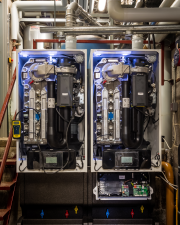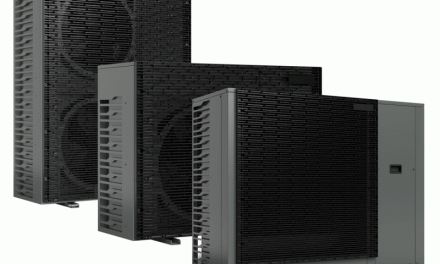As air quality comes increasingly under the spotlight, James Porter, Sales Director at Remeha, looks at the benefit of specifying low NOx condensing boilers to reduce pollution from heating
 Just five days into 2017, London breached the legal limit for toxic air for the entire year. UK Air Quality Standards Regulations stipulate that hourly levels of toxic nitrogen dioxide must not exceed 200 milligrams per cubic metre more than 18 times a year. Yet this limit was broken on 5 January in Brixton Road in Lambeth – with many more sites across London set to follow suit.
Just five days into 2017, London breached the legal limit for toxic air for the entire year. UK Air Quality Standards Regulations stipulate that hourly levels of toxic nitrogen dioxide must not exceed 200 milligrams per cubic metre more than 18 times a year. Yet this limit was broken on 5 January in Brixton Road in Lambeth – with many more sites across London set to follow suit.
And poor air quality is not restricted to the capital as it was revealed last year that most UK cities and towns currently exceed WHO guidelines. This has brought new scrutiny of nitrogen oxides, or NOx – polluting gases that can affect lung function and breathing and worsen asthma. The Department for Environment, Food and Rural Affairs (Defra) claims that pollution from NOx is responsible for the premature death of 23,500 citizens each year in the UK alone.
So how to improve the quality of the air we breathe and what role can energy managers play? Vehicle exhausts are a major contributor to outdoor pollution, but buildings also typically emit NOx. And with heating responsible for around half a building’s total energy consumption, reducing the emissions from this service is an excellent starting point for NOx reduction.
Engineering for low NOx heating
In recent years, built environment legislation has centred on reducing carbon dioxide to help meet targets set in the UK Climate Change Act 2008. But engineering for low NOx is not a new concept in heating.
The environmental assessment scheme BREEAM has certified and rated the sustainability of buildings since 1990 across a range of criteria from energy to ecology. The Pol 2 NOx emissions category aims “to contribute to a reduction in national NOx emission levels through the low use of emission heat sources in the building.” A maximum of three credits are awarded for heating plant that, under normal conditions, has a dry NOx emission level up to or less than 40mg/kWh. These low NOx credits and those from each category together provide a final building rating.
Financial and health benefits
Higher BREEAM ratings bring clear environmental and financial advantages. Due to the core values of BREEAM, buildings with higher ratings are likely to generate environments that are more sustainable to operate, reducing energy costs and helping meet ‘green’ targets. At the same time, there is a growing connection between credited sustainable buildings and increased employee wellbeing. Better air quality encourages improved health, leading to enhanced performance and greater productivity – all of which boosts the bottom line.
2018 mandatory NOx requirements
And from September 2018, mandatory NOx heating requirements will be enforced. In September 2015, the Ecodesign of Energy-related Products Directive (ErP) introduced tighter energy efficiency standards for all space heaters up to and including 400kW on both new build and refurbishment projects. Now it’s turning its attention to low NOx – a maximum NOx emissions of 56mg/kWh will be imposed for gas and liquefied petroleum gas (LPG) boilers and a maximum of 120mg/kWh for oil fired boilers.
Engineering for low NOx heating
The aim is to ensure that only the most energy-efficient, low NOx heating products are manufactured, specified and installed across the UK and Europe. Commercial boiler plant is a popular, tried-and-tested source of heating in the UK’s new and existing buildings. And fortunately, we already have an affordable, highly-efficient, low NOx heating solution in condensing boilers.
Modern condensing boilers are the most efficient of all boiler technologies, offering high efficiencies of around 98% gross. Lighter and more compact with increasingly flexible design options, they are easy to install and maintain, reducing labour costs, minimising any disruption and lowering lifetime operating and service costs.
And when it comes to clean air, condensing boilers like the Remeha range are designed and engineered for ultra-low NOx emissions.
Using the most sophisticated technology, advanced boilers like the Remeha Quinta Ace 160 can achieve near maximum efficiency with NOx emissions as low as 35 mg/kWh. As a result they meet the highest performing NOx class relating to gas-fired boilers, EN15502 Pt 1 2015 Class VI. In addition, they are eligible for maximum BREEAM credits, helping improve a building’s environmental rating and generating a more sustainable working environment. And last but not least, they are future-proofed to ErP Ecodesign (iii) 2018 NOx legislation.
With a cost-effective solution already here, what steps can and should energy managers take to ensure good air quality?
· Always specify high-efficiency, low NOx heating products in new build developments and on refurbishment projects
· Consider replacing any old boilers with high-efficiency, low NOx solutions such as condensing boilers. Even with good maintenance programmes, a 25-year-old boiler will only achieve a maximum gross efficiency of around 70% with high NOx emissions
· Size the heat load accurately and add the appropriate controls – this will maximise heating performance and optimise energy-efficient, low NOx operation.
Condensing boiler technology offers a simple, hassle-free route to low NOx heating. A versatile quick win to significant carbon and energy savings on retrofit projects and a reliable, energy-efficient source of heating in both new and old developments, condensing boilers also deliver on a practical and financial level. So as the campaign for cleaner air gains momentum, is it time to future-proof your heating?
For further details, please visit www.remeha.co.uk



